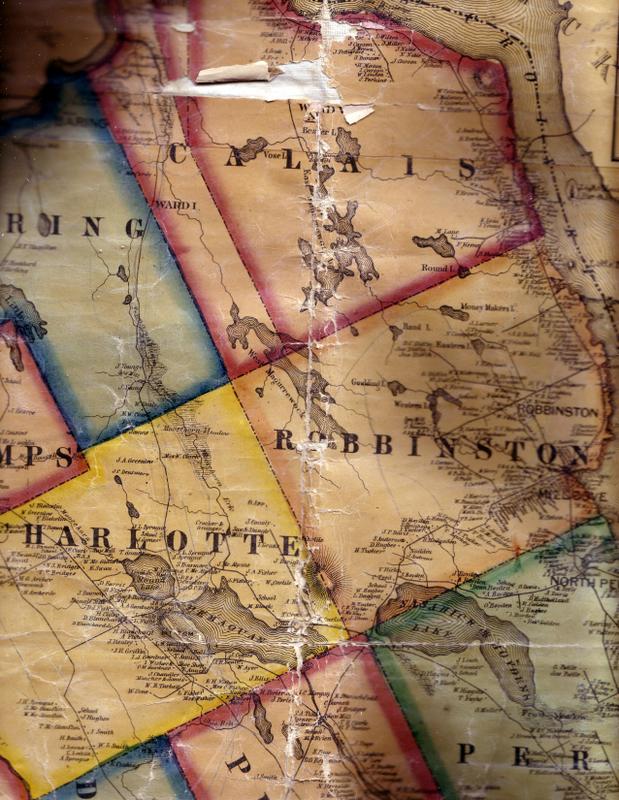

We found an enchanting article in the July 1878 Advertiser written by Henrietta Keene describing Keene’s Lake and its surroundings as she remembers them as a young woman. As you can see from the 1881 map above there were but three families on the lake when Henrietta wrote the article—the Frederick Keene homestead where Henrietta grew up and two Lane homes a bit further out the road we know today as the Shattuck Road. Ben Shattuck lived at the end of the other fork in the road. On the map Keene’s Lake has no name but what is today Shattuck Lake is called Round Lake.
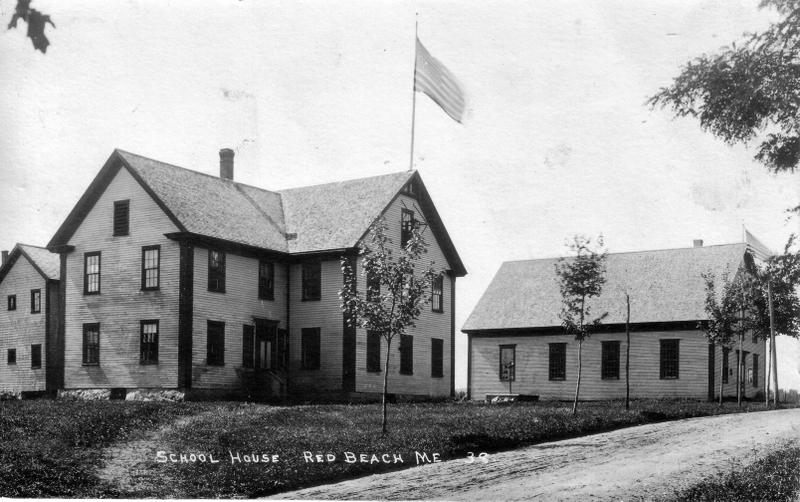
We are not sure when Henrietta was born but we know she was raised at the Keene farm on the lake and was living there in 1878 when she wrote the article. As late as 1896 she was living with Fred T. Keene in Red Beach—we presume on the lake. This is verified by her nephew, Frederick W. Keene, who wrote the many historical articles about Red Beach which Fred Becker compiled in the society’s publication Keene on Red Beach.
Frederick W. Keene remembers:
“Listening long winter evenings to my aunt running through Beethoven and Mozart sonatas and an all-classical program. One of her lessons was named the Happy farmer. Grandmother would sometimes say when we had company: “Play that…….lie about the farmer”.
She almost certainly attended the Red Beach school although it may have been an earlier version than the one above and after finishing school, she wrote articles for the Calais Advertiser such as the one below and was an accomplished musician. After she moved to Calais about 1900, she gave music lessons and lived at 3 Franklin Street. In her later years she moved to Lubec and lived with her nephew Fred until her death in 1947.
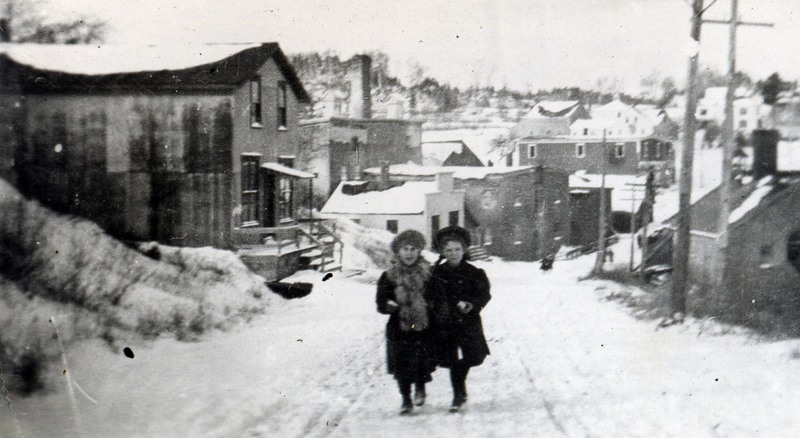
Above is a photo of a couple of young ladies walking north up Route 1 in Red Beach toward Calais around the time Henrietta was a resident of Red Beach. We’d like to be able to claim she’s one of the girls but we think the photo is of the Brown girls walking home to Brooks Bluff.
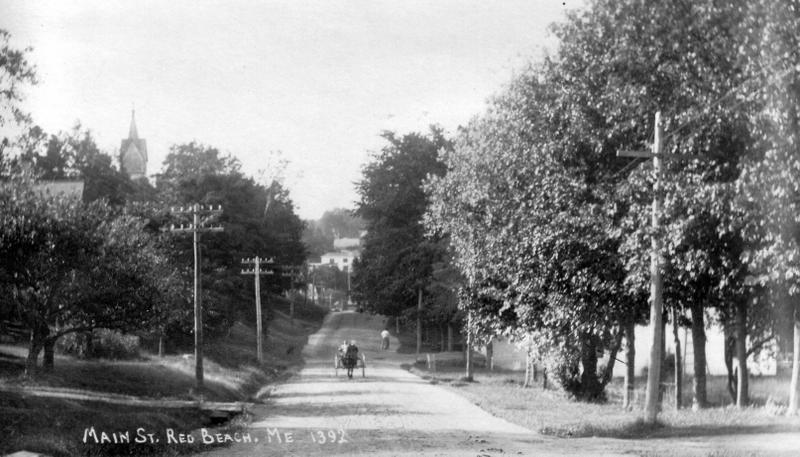
Henrietta would have been very familiar with this scene at the end of the Shattuck Road looking North toward the village. The photo is a bit later than the article of 1878 which, at long last, we reproduce in its entirety as it appeared in the Advertiser. It was written without paragraphs, and she spelled her name “Keen”
Henrietta Keen July 22. 1878 Calais Advertiser:
If you will imagine yourself seated on a rustic seat on the lawn in front of my dear old home, dear for all the recollections and associations of my life.- For here I was born and have lived the whole of my secluded but happy life I will endeavor to give a description of the scenery connected with my home and its surroundings, with other thoughts which may occur to me. My home is situated by the side of a beautiful grove, on a high elevation of land overlooking a charming little lake, and commands an extensive and interesting view of the wooded hills, rugged mountains and quiet valleys stretching away into the far distance where mountains and sky mingle in similarity. A short distance from my home, guarded by waving trees and creeping vines lies the lake, a splendid picture set in mountain scenery sloping down to its sanded beach. Come with me to the landing, seat yourself in this boat, and I will row you over the lake, and we will ascend yonder mountain. For twenty years my father has been setting cranberry vines upon the margin of the lake. And you see these shores are nearly occupied with vines and are protected from the water of the lake by a wall of rocks. Yonder are our old loons and their young. How gracefully they sit upon the water. I call them ours, because for years we have protected them from the shot of the sportsman. For years we have listened to their call, and enjoyed their laughter, for they return yearly, and on yonder little island under the mountain build their nests, and in these waters rear their young. Crazy and wild as a loon is the common expression, but not applicable to these loons. I will row up to them, see how they thrash their wings, and hear them call their young to follow. But they will not. l will call and they will come to me. Please take them gently into the boat. Are they not beautiful in their soft velvety dress? I often take them on shore. It is only for a short time that they are so tame, as soon as they learn to dive, they become shy and you can no longer catch them. As we pass along let us gather a bunch of those lilies on our right. At a distance they look like little bunches of snowy down resting upon the surface of the water, surrounded by glossy green leaves. Here you see them in all their stages of growth, some fully developed, others partially expanded, and some tiny buds just leaving the root at the bottom of the lake. Are they not beautiful, and their fragrance how peculiarly sweet, but their lives are brief, in a few days they will decay, not to display their beauty until another year. With a few long strokes of the oars we are away, from the lilies, our boat cutting the limpid water, and sending out a Iong rippling wake of millions of sparkling rubies. The little islands of this lake look like wreaths of evergreens, placed upon acres of mirrors, and seem to look back to the stern rugged mountains to protect them in their beauty. They are like pictures set where they harmonize in grateful relief on the dark background. In ascending the mountain, I will say unto you as was said unto Lot and his family “Do not look behind thee” but would not attach the same penalty. I think that viewing the scenery as one ascends takes much from the beauty as seen from the summit. It is to these quiet nooks under the cliffs of rocks that I repair in early spring to gather the sweet-scented creeping arbutus, to perfume and decorate my home. Seat yourself upon this cliff of rocks and while you view the surrounding scenery, I will relate a story or legend of this mountain. An Indian returning to our house from this place stood facing the lake and mountain, and with a graceful wave of the hand, related the following story. “Yes very same place my father he tell um, see um great many lakes-A great many years ago my father he camp on this mountain, no not my father my father’s father, no great many fathers before my father’s father, great many years fore the white man he come. He one morning out hunting, see um very strange tracks, very much scared, go home quick, take squaws and papooses start for Red Beach, go all the way down Pleasant point , walk um in water so they can no smell um tracks, put um all the papooses in one wigwam, dig very deep pits all around, watch um all night, next morning kill two very big lions.” This quiet beauty of a lake directly before us is owned by Ben Shattuck, an old gentleman living on yonder gentle swell of land and bears his name. He is our pioneer in the cultivation of cranberries. On our right lies Moneymaker Lake, named and noted for the tragedy enacted in 1810 with the facts of which you are already familiar. In the vicinity of this place lies six beautiful lakes, two of which are three miles long and furnish excellent trout fishing. From this mountain a grand and beautiful view stretches out for many miles before you over the hills, valleys and crystal lakes, to the blue waters of the St. Croix. This river is traversed on its dominion side by a chain of mountains, some of which are very elevated, and form a magnificent background to its clear sparkling waters. Soon the green banks of this river will be dotted with the white tents of pleasure and health seekers who will wisely leave their dusty city homes to spend a few weeks amid the splendid scenery, the cool invigorating breezes and quietude of the country. We sadly regret there are not a thousand of these tents where there is one and would recommend this mode of pleasure seeking to the packing of huge trunks for Saratoga, and other fashionable resorts. The sun is fast sinking and we will retrace our steps down the mountain. Passing through the fringe of bushes we are again on the shore of this lovely lake, whose calm quiet water reflects the glory of the setting sun and the splendors of the solemn Western sky.
As Henrietta mentions Ben Shattuck and cranberries on a couple of occasions we’ll end with a bit of local cranberry history, date unknown but written well before 1900:
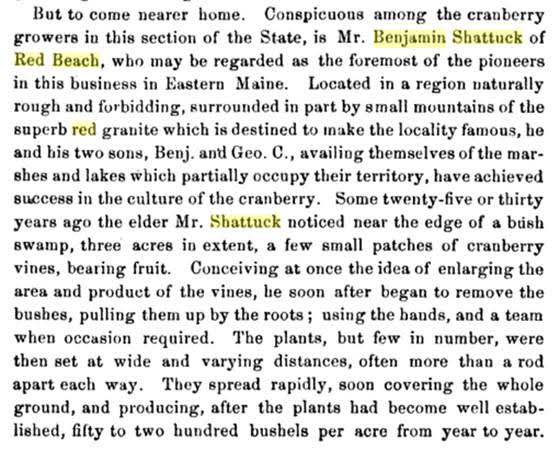
If anyone can tell us more about the location of the Fred Keene Homestead on the lake or the mountain she climbed after she crossed the lake, we would like to include it in the historical record.
